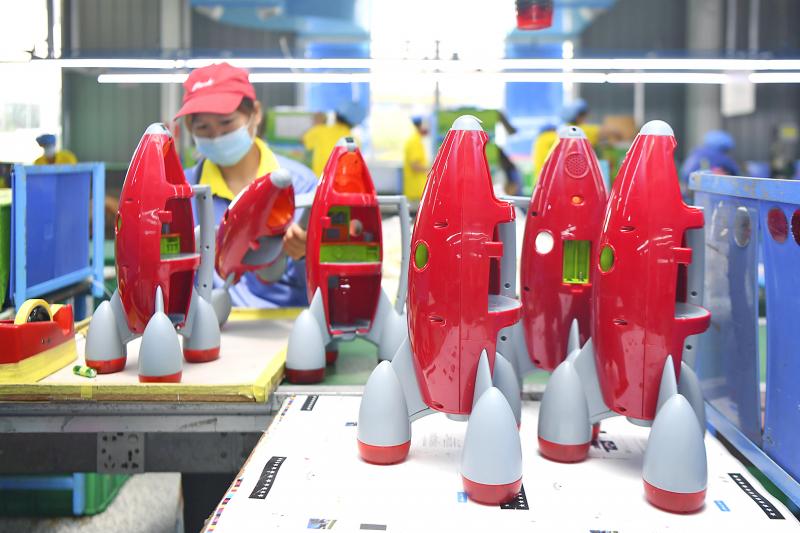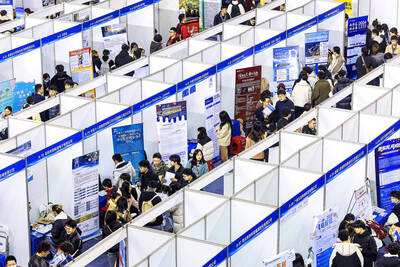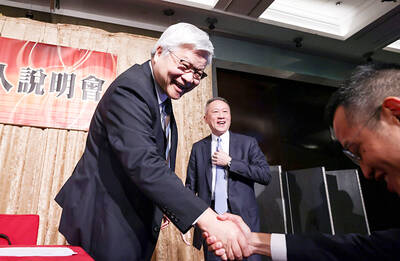China’s factory activity picked up pace last month, official data showed yesterday, although analysts warned that weak global demand and a potential COVID-19 resurgence are weighing on its longer-term recovery.
The world’s second-largest economy has been whirring back to life after the virus and sweeping lockdowns prompted a near-halt in activity at the start of the year.
However, economists have warned that momentum might weaken in the second half of the year as key markets struggle to recover from the crisis and as orders for medical supplies abroad — which have boosted exports — peak and fall.

Photo: AP
China’s purchasing managers’ index (PMI), a key gauge of activity in factories, came in at 50.9 points last month, better than the 50.5 forecast in a Bloomberg News poll of analysts and up 0.3 points from May.
Anything above 50 is considered to show expansion.
The non-manufacturing PMI came in at 54.4 points from 53.6, according to the Chinese National Bureau of Statistics.
The readings would be welcomed as the economy slowly emerges from the disease, having shrunk in the first quarter for the first time in decades.
Bureau senior statistician Zhao Qinghe (趙清河) said that the surprise uptick came as “supply and demand continued to pick up” last month, while imports and exports are also looking better as major global markets restart their economies.
However, he warned that there were still “uncertainties,” with the import and export indices below the 50 mark and a larger number of small enterprises reporting a lack of orders.
United Overseas Bank Ltd (大華銀行) economist Chen Ho Woei (陳浩偉) told reporters that the poorer performance of small businesses suggests China’s government needs to continue providing targeted support.
While there was a relatively good recovery in the second quarter, Nomura Holdings Inc chief China economist Lu Ting (陸挺) flagged “strong headwinds ahead and heightened uncertainty.”
“The momentum could lose some steam in coming months,” he said.
Lu told reporters that the manufacturing PMI improvement might have been driven by an improvement in new export orders, but they remained in contraction territory, adding that the fall in the employment sub-index also did not bode well.
“The rebound in new COVID-19 cases in Beijing and some surrounding cities dealt a blow to the service sector,” he said, adding that recent data suggested no clear recovery in tourism in the past few months.
Martin Rasmussen of Capital Economics added that overseas shipments “look ripe for a pullback, despite the improvement in export orders,” with demand for virus-related products, such as masks, that were needed in the global outbreak likely to weaken.
“But the continued rapid issuance of government bonds means that infrastructure spending should remain strong and help keep the recovery on track,” he said.

Stephen Garrett, a 27-year-old graduate student, always thought he would study in China, but first the country’s restrictive COVID-19 policies made it nearly impossible and now he has other concerns. The cost is one deterrent, but Garrett is more worried about restrictions on academic freedom and the personal risk of being stranded in China. He is not alone. Only about 700 American students are studying at Chinese universities, down from a peak of nearly 25,000 a decade ago, while there are nearly 300,000 Chinese students at US schools. Some young Americans are discouraged from investing their time in China by what they see

MAJOR DROP: CEO Tim Cook, who is visiting Hanoi, pledged the firm was committed to Vietnam after its smartphone shipments declined 9.6% annually in the first quarter Apple Inc yesterday said it would increase spending on suppliers in Vietnam, a key production hub, as CEO Tim Cook arrived in the country for a two-day visit. The iPhone maker announced the news in a statement on its Web site, but gave no details of how much it would spend or where the money would go. Cook is expected to meet programmers, content creators and students during his visit, online newspaper VnExpress reported. The visit comes as US President Joe Biden’s administration seeks to ramp up Vietnam’s role in the global tech supply chain to reduce the US’ dependence on China. Images on

New apartments in Taiwan’s major cities are getting smaller, while old apartments are increasingly occupied by older people, many of whom live alone, government data showed. The phenomenon has to do with sharpening unaffordable property prices and an aging population, property brokers said. Apartments with one bedroom that are two years old or older have gained a noticeable presence in the nation’s six special municipalities as well as Hsinchu county and city in the past five years, Evertrust Rehouse Co (永慶房產集團) found, citing data from the government’s real-price transaction platform. In Taipei, apartments with one bedroom accounted for 19 percent of deals last

US CONSCULTANT: The US Department of Commerce’s Ursula Burns is a rarely seen US government consultant to be put forward to sit on the board, nominated as an independent director Taiwan Semiconductor Manufacturing Co (TSMC, 台積電), the world’s largest contract chipmaker, yesterday nominated 10 candidates for its new board of directors, including Ursula Burns from the US Department of Commerce. It is rare that TSMC has nominated a US government consultant to sit on its board. Burns was nominated as one of seven independent directors. She is vice chair of the department’s Advisory Council on Supply Chain Competitiveness. Burns is to stand for election at TSMC’s annual shareholders’ meeting on June 4 along with the rest of the candidates. TSMC chairman Mark Liu (劉德音) was not on the list after in December last